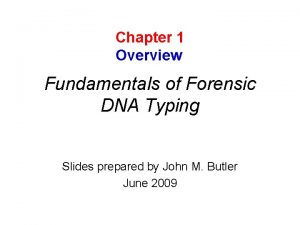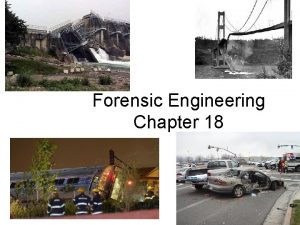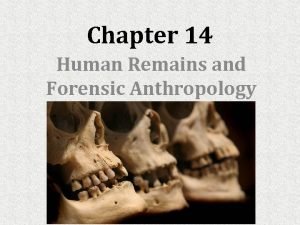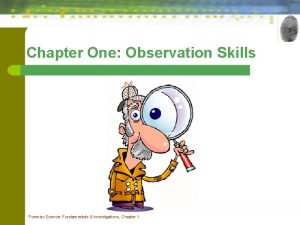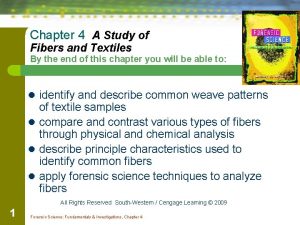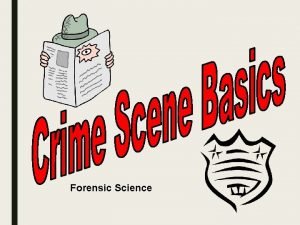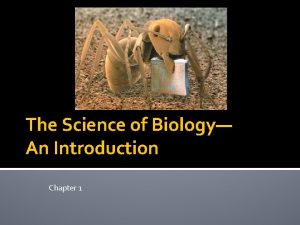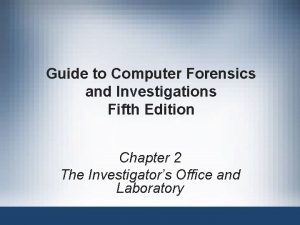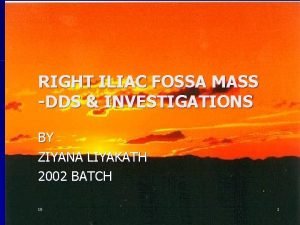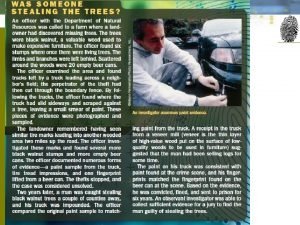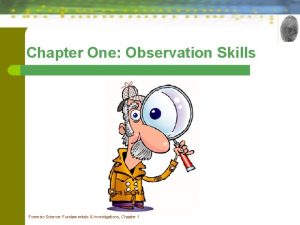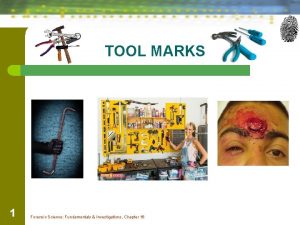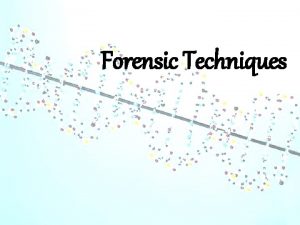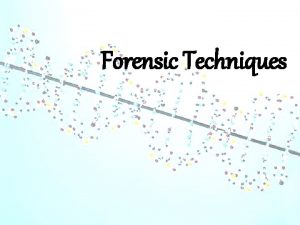1 Forensic Science Fundamentals Investigations 2 e Chapter


























- Slides: 26

1 Forensic Science: Fundamentals & Investigations, 2 e Chapter 14 All rights Reserved Cengage/NGL/South-Western © 2016

Chapter 14 Forensic Anthropology By the end of this chapter you will be able to: 14. 1 Summarize the information a forensic anthropologist derives from skeletal remains to construct a biological profile. 14. 2 Distinguish among growth plates, bone caps, bone shafts, and sutures, and explain their significance forensic anthropology. 14. 3 Compare and contrast an adult’s skeleton and a child’s skeleton in terms of composition, number of bones, suture marks, and growth plates. 2 Forensic Science: Fundamentals & Investigations, 2 e Chapter 14 All rights Reserved Cengage/NGL/South-Western © 2016

Chapter 14 Forensic Anthropology By the end of this chapter you will be able to: 14. 4 Apply knowledge of bone growth (ossification) to estimate the age of the deceased at the time of death based on skeletal remains. 14. 5 Apply appropriate formulas to estimate the height of a person based on individual bone length. 14. 6 Distinguish between male and female skeletal remains based on the structure, the size and shape of the skull, the pelvis, and the long bones. 3 Forensic Science: Fundamentals & Investigations, 2 e Chapter 14 All rights Reserved Cengage/NGL/South-Western © 2016

Chapter 14 Vocabulary o o o 4 biological profile diaphysis epiphysis forensic anthropology growth plate (epiphyseal plate) o o Forensic Science: Fundamentals & Investigations, 2 e Chapter 14 joints ossification osteoporosis skeletal trauma analysis All rights Reserved Cengage/NGL/South-Western © 2016

Introduction o o o Forensic anthropology uses skeletal anatomy to identify remains. After bones are identified as human, the shape, structure, condition, and measurements of the remains are recorded. Other means of identifying remains include: • • 5 DNA extraction Serial numbers of implanted medical devices Forensic Science: Fundamentals & Investigations, 2 e Chapter 14 All rights Reserved Cengage/NGL/South-Western © 2016

Characteristics of Bone o Bones: • • • 6 Provide the framework for our bodies Anchor our muscles to allow movement Protect our vital organs Forensic Science: Fundamentals & Investigations, 2 e Chapter 14 All rights Reserved Cengage/NGL/South-Western © 2016

How Bones Connect o A joint is the location where bones meet. • • • 7 Cartilage Ligaments Tendons Forensic Science: Fundamentals & Investigations, 2 e Chapter 14 All rights Reserved Cengage/NGL/South-Western © 2016

Number and Development of Bones o o o 8 A baby has 270 bones. Adults have 206 bones. For some bones, ossification takes more than 50 years. Forensic Science: Fundamentals & Investigations, 2 e Chapter 14 All rights Reserved Cengage/NGL/South-Western © 2016

9 Forensic Science: Fundamentals & Investigations, 2 e Chapter 14 All rights Reserved Cengage/NGL/South-Western © 2016

Bones and Biological Profiles o Bones contain a "diary” of injuries, disease, and nutritional deficiencies. • • • 10 Broken bones Osteoarthritis Osteoporosis Rickets Severe anemia Cancer Forensic Science: Fundamentals & Investigations, 2 e Chapter 14 All rights Reserved Cengage/NGL/South-Western © 2016

How to Distinguish Males from Females o o o 11 The overall appearance of the adult female’s skeleton tends to be more slender than that of an adult male’s skeleton. Muscles tend to be more developed in the male. The determination of sex by skeletal remains can only be done if the deceased is passed puberty. Forensic Science: Fundamentals & Investigations, 2 e Chapter 14 All rights Reserved Cengage/NGL/South-Western © 2016

12 Forensic Science: Fundamentals & Investigations, 2 e Chapter 14 All rights Reserved Cengage/NGL/South-Western © 2016

13 Forensic Science: Fundamentals & Investigations, 2 e Chapter 14 All rights Reserved Cengage/NGL/South-Western © 2016

14 Forensic Science: Fundamentals & Investigations, 2 e Chapter 14 All rights Reserved Cengage/NGL/South-Western © 2016

Pelvis o 15 Examining the pelvis is one of the most reliable methods of determining the sex of an adult skeleton. Forensic Science: Fundamentals & Investigations, 2 e Chapter 14 All rights Reserved Cengage/NGL/South-Western © 2016

16 Forensic Science: Fundamentals & Investigations, 2 e Chapter 14 All rights Reserved Cengage/NGL/South-Western © 2016

17 Forensic Science: Fundamentals & Investigations, 2 e Chapter 14 All rights Reserved Cengage/NGL/South-Western © 2016

Pelvis (continued) o To distinguish between the male and female pelvis, compare the following: • • 18 Subpubic angle Length, width, shape, and angle of the sacrum Width of the ilieum Angle of the sciatic notch Forensic Science: Fundamentals & Investigations, 2 e Chapter 14 All rights Reserved Cengage/NGL/South-Western © 2016

Bones and Geography o Bones indicate were you have eaten your food. • • • 19 Strontium Carbon-13 Carbon-12 Forensic Science: Fundamentals & Investigations, 2 e Chapter 14 All rights Reserved Cengage/NGL/South-Western © 2016

Estimating Age 20 Forensic Science: Fundamentals & Investigations, 2 e Chapter 14 All rights Reserved Cengage/NGL/South-Western © 2016

Teeth 21 Forensic Science: Fundamentals & Investigations, 2 e Chapter 14 All rights Reserved Cengage/NGL/South-Western © 2016

Skull Suture Marks 22 Forensic Science: Fundamentals & Investigations, 2 e Chapter 14 All rights Reserved Cengage/NGL/South-Western © 2016

Skull Suture Marks 23 Forensic Science: Fundamentals & Investigations, 2 e Chapter 14 All rights Reserved Cengage/NGL/South-Western © 2016

How to Distinguish Ancestry 24 Forensic Science: Fundamentals & Investigations, 2 e Chapter 14 All rights Reserved Cengage/NGL/South-Western © 2016

How to Estimate Height 25 Forensic Science: Fundamentals & Investigations, 2 e Chapter 14 All rights Reserved Cengage/NGL/South-Western © 2016

Skeletal Analysis and Identification o o o 26 Comparative Radiography Nonimaged Records Comparison DNA Analysis Photographic or Video Superimposition Craniofacial Reconstruction Forensic Science: Fundamentals & Investigations, 2 e Chapter 14 All rights Reserved Cengage/NGL/South-Western © 2016
 Forensic science fundamentals and investigations chapter 6
Forensic science fundamentals and investigations chapter 6 Thomas mocker and thomas stewart
Thomas mocker and thomas stewart Who is this
Who is this Fundamentals of forensic dna typing
Fundamentals of forensic dna typing The golden book of camping
The golden book of camping What is nibis
What is nibis Chapter 14 forensic anthropology
Chapter 14 forensic anthropology Observation in forensic science
Observation in forensic science Weave patterns of fibers forensics
Weave patterns of fibers forensics Chapter 1 intro to forensic science
Chapter 1 intro to forensic science Criminalistics
Criminalistics Forensic science chapter 2 vocabulary
Forensic science chapter 2 vocabulary Forensic science chapter 1
Forensic science chapter 1 What is my favourite subject
What is my favourite subject Why aren t descriptive investigations repeatable
Why aren t descriptive investigations repeatable Nrich maths investigations
Nrich maths investigations Craigslist private investigator
Craigslist private investigator Guide to computer forensics and investigations
Guide to computer forensics and investigations Statistical investigations unit 3 section a
Statistical investigations unit 3 section a Types of statistical investigation
Types of statistical investigation Heatherdowns bmv
Heatherdowns bmv Scientific method conclusion
Scientific method conclusion Pasco child protective services
Pasco child protective services Chs investigations
Chs investigations Forensics
Forensics Right iliac fossa mass investigations
Right iliac fossa mass investigations Jarrod bowditch
Jarrod bowditch



